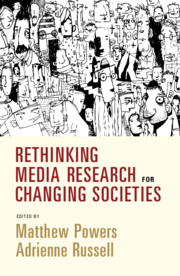Book contents
- Rethinking Media Research for Changing Societies
- Communication, Society and Politics
- Rethinking Media Research for Changing Societies
- Copyright page
- Contents
- Figure
- Contributors
- Acknowledgments
- 1 Introduction
- Part I Living in a Datafied World
- Part II Journalism in Times of Change
- Part III Media and Problems of Inclusion
- 7 Journalism and Inclusion
- 8 Afrotechtopolis
- 9 Exploiting Subalternity in the Name of Counter-Hegemonic Communication
- Part IV Engagement with and through Media
- Part V The Role of Scholars
- Other Books in the Series (continued from page ii)
- References
7 - Journalism and Inclusion
from Part III - Media and Problems of Inclusion
Published online by Cambridge University Press: 18 September 2020
- Rethinking Media Research for Changing Societies
- Communication, Society and Politics
- Rethinking Media Research for Changing Societies
- Copyright page
- Contents
- Figure
- Contributors
- Acknowledgments
- 1 Introduction
- Part I Living in a Datafied World
- Part II Journalism in Times of Change
- Part III Media and Problems of Inclusion
- 7 Journalism and Inclusion
- 8 Afrotechtopolis
- 9 Exploiting Subalternity in the Name of Counter-Hegemonic Communication
- Part IV Engagement with and through Media
- Part V The Role of Scholars
- Other Books in the Series (continued from page ii)
- References
Summary
This chapter asks whether news organizations, organizations, in their search for sustainable business models, are acting increasingly as a force for exclusion. Rodney Benson identifies two forms this exclusion takes. In some cases, the exclusion is economic, as happens when subscriptions are too expensive for audience members who might otherwise consume such news. In other cases, the exclusion is cultural, which can be seen in publications freely available to all but in fact only attract the interest of those with proportionally larger volumes of economic and cultural resources than the average member of the public. Benson calls for scholars to see exclusion as socially organized and to aid in the search for solutions to the problem of “civic” inclusion, which he imagines will include media literacy initiatives, newsroom recruitment to ensure better representation of people from diverse background, government policies to support independent media, and a range of other initiatives.
- Type
- Chapter
- Information
- Rethinking Media Research for Changing Societies , pp. 91 - 104Publisher: Cambridge University PressPrint publication year: 2020
References
- 1
- Cited by



